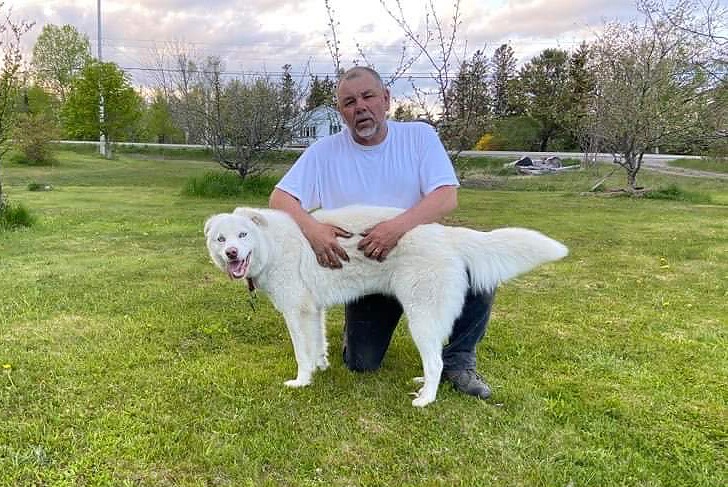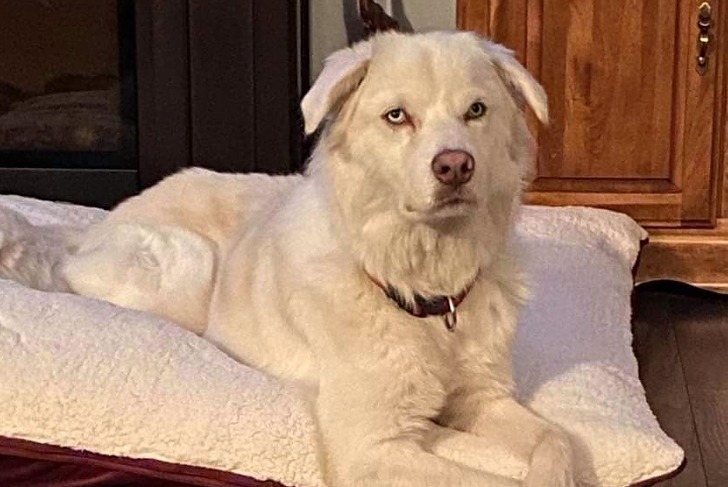The animals that touch my life never cease to amaze me in the way their unspoken wisdom is a constant reminder of the riches we already have. I don’t mean what is coming or what we are waiting for, but what we possess in each and every moment and can share not only with them but the world we live in. Those riches are energy, love, touch, joy, and wonder.
You are probably wondering what this has to do with an article on deaf dog awareness… keep reading and you will find out:)
Believe it or not, many of us could actually be living with a hearing impaired or deaf dog at some point. Many of us who’ve been blessed with the gift of our dogs growing old will have experienced some sort of hearing loss. This is often a regular part of growing older. Other dogs lose their hearing because of chronic ear infections, head injuries, or drug toxicity, degenerative nerve changes, tumors or ruptured ear drums. Then there is the unexpected surprise to find out your puppy is deaf (usually from a congenital issue). Then of course there are those incredible people out there who intentionally adopt a deaf dog! But at the end of the day, many pet parents will, at some point, live with some sort of hearing situations with their fur kids.
Knowing that, there is some key information I’d like to share, then I will get back to energy, love, touch, joy, and wonder.
Reasons for Hearing Loss and Deafness in Dogs
As I mentioned, there are several reasons a dog might lose their hearing:
- congenital deafness
- chronic ear infections
- ototoxicity
- trauma to the ear
- age
When it comes to congenital deafness, from what I have researched, Dalmatians seem to be the most at risk. In fact, up to 1/3 of Dalmatian puppies are born deaf in one or both ears.
Other breeds who tend towards deafness are:
- Bull terriers
- Whippets
- White boxers
- English setters
- Australian cattle dogs
- Jack Russell terriers
- Catahoula leopard dogs
The majority of all congenital-based deafness happens to dogs with partially or all white heads. As you might have noticed, most dogs on the above list have white heads!
Studies show that one reason for this is related to the pigment cells of the inner ear. Your dog needs pigment cells for healthy nerve cells. A lack of pigment leads to the death of the nerve cells, causing a default in development for hearing to occur. What’s really interesting, though, is naturally solid white breeds like the Samoyed or Spitz have no problems with deafness.
Other causes can include:
- Chronic ear infections can also cause scaring or narrowing of the ear canal or a ruptured ear drum.
- Toxic industrial solvents. These harsh, toxic chemicals can also cause trauma to the ear. Watch out for toluene, organotins.
- Environmental noise, especially with hunting dogs, fireworks, and constant loud music or machinery can all lead to hearing loss.
- Head trauma. If a dog is hit by car, for example, or any accident causing head trauma can result in deafness.
- With natural aging, over time sensory hair cells of the inner ear are exposed to continuous mechanical stress, causing damage. Then further trauma to the cells can be caused by a variety of other ototoxic factors including loud noises, genetic defects, ototoxic drugs, chronic inflammation, or infection.
- Ototoxicity in dogs and cats – this is drug toxicity that causes hearing loss.
Deaf Dog Awareness: Drug Toxicity
When you read this you might be shocked to see that two of the leading ear ointments used to treat ear infections can also cause deafness! As with all drugs, please always weigh the risk vs. the benefits and use all drugs as a last choice rather than a go-to or first choice. There are so many amazing natural tools to deal with ear infections that get to the core issue with no side effects. Work with a qualified holistic veterinarian or animal health practitioner for best results.
Common veterinary drugs that can cause ototoxicity:
- Otomax Otic Ointment – used for the treatment of canine acute and chronic otitis externa associated with yeast (Malassezia pachydermatis) and/or bacteria susceptible to gentamicin.
- Gentamicin – Otic Gentamicin (brand names: Gentocin®, Genoptic®, Gentak®) is an aminoglycoside antibiotic for treating certain bacterial ear infections.
- Mometamax, GenOne – antibiotic with corticosteriod
- Aminoglycoside antibiotics – streptomycin, neomycin
- Antineoplastics – cisplatin, carboplatin
- Diuretics – ethacrynic acid, furosemide
- Analgesics, antipyretics – salicylates
- Polypeptide antibiotics – viomycin, vancomycin
- Macrolide antibiotics – erythromycin
Scientific studies show a link between all of these drugs and deafness!
Signs of Dog Deafness
What signs can you watch for if you think your dog is losing their hearing?
- Change in recall or simple sit, stay, or attentiveness
- Less responsive to things they would normally react to like the doorbell or vacuum, barking on the TV, etc.
- Does not pay attention to his/her name
- Hard to wake up from sleep
- Less enthusiastic about going for walks
- Bark excessively
- Shake or tilt his/her head
- Increased fearfulness is normally non-fearful situations
Sometimes it is a gradual thing, something you’ll notice over time. Other times it might be immediate. Pay attention to the simple cues.
Ways to Protect Your Dog’s Hearing
As you may have noticed, some of the causes of hearing loss are avoidable, even with regard to age. There are several things that you can do as a pet parent to protect your dog’s hearing.
- Avoid sudden loud noises
- Provide species-appropriate fresh food
- Avoid exposure to load repetitive noise from music or machinery
- Avoid sharp or high pitched noises
- Use supplements that maintain overall health
- Maintain great gut health with a healthy microbiome
- Be very cautious during holiday or family festivities, holiday fireworks, Christmas crackers, bangers, Halloween screaming children, etc. Make sure your dog has a space to go to get quiet. Don’t force them there, but be sure they can get to it when their ears are becoming sensitive!
- Use a holistic practitioner to deal with ear inflammation and infections to prevent scaring and toxicity via drugs
- Carefully clipping the surface hair of your dog’s ear flap to keep it short can help prevent a buildup of debris and is a much better alternative to plucking! Make sure the fine hairs do not fall into the ear. Plucking hair from the ear canal may lead to microtrauma and inflammation in the ear that can predispose your dog’s ears to infection.
Can You Train/Teach a Deaf Dog?
Did you know that learning new skills for the pet parent is linked to better brain function! Science shows that people who continue to learn new things have healthier brains, less incidences of loosing their memory, better cognitive function, and it keeps your brain young! So, having a deaf dog teaches us to think outside the box and learn new ways to communicate, all supporting our own health and well being.
This was a little bit of information on the fly from my good friend, trainer Even Doggett, when I asked him what I could say about training. Here’s what he had to say:
“I would remind people that dogs’ primary communication skill is body language. They use it every day to communicate with each other as to whose bone this is, who is in charge, whether they want to play, fight, frolic, or fornicate. Most everything is spoken non-verbally. And so do we communicate with our fellow humans. With approximately 10,000 facial expressions, perhaps we are not all that different than our furry friends. Every one of our body movements already means something to the dog. Therefore, all we need to do, if we want them to still “listen” to us, is put some intent behind those actions and voilà you are on your way to having a trained deaf dog! – Talk soon, E Diggity Dogg
See more about Evan and his training below!!
Keeping Your Deaf Dog Safe
Always remember, deaf dogs are not broken. They are simply dogs who can not hear. Please take the obvious steps to keep them safe around cars or anything dangerous they can not hear.
I have heard of people putting bells on their collars so you know where they are. Be sure to have contact information if they get lost and that the dog a person has found is deaf!
Now, remember at the beginning I said “The animals that touch my life never cease to amaze me in the way their unspoken wisdom is a constant reminder of the riches we already have. I don’t mean what is coming or what we are waiting for, but what we possess in each and every moment and can share not only with them but the world we live in. Those riches are energy, love, touch, joy, and wonder.” This is what I was referring to…
For some of us, when we think of a deaf dog, our hearts break or we feel they’re lacking in some way. Dogs have much more sensitive hearing than humans. They can not only hear four times farther but can pinpoint the exact location the sound is coming from. The reason they can hear things we simply can not is that they can hear higher and totally different frequencies. We all know that a dog can recognize the sound of our car, but did you know that if everyone drove the exact same car, your dog would still know whether or not it was you pulling into the driveway?! It’s true.
Look to their joy!
In light of this incredible gift, how can we not feel that our dogs would be missing out or not have the quality of life that a dog with hearing would? Well, here is their lesson to us: dogs look for joy! Their resilient energy and open heart is always abundant. They shift their focus quickly to always find love and fun.
Dogs don’t stay in lack; they use the rest of their senses to breathe in all the amazing things we take for granted, like the smell of the dirt, the trees, food cooking, the rain, all the things that can bring us gratitude and make us feel alive, things that are right now. They see the wonder in a leaf blowing or even seeing us walking up the steps that send them over the edge with excitement. When was the last time you took the time to see your husband, wife, child, mother, father, friend, or even your dog come up the steps and feel your heart skip a beat for the amount of love and joy you have that they are just in your life?
Communication happens every single time you touch your dog. If you’re in a bad, sad, or happy mood, your pup clearly understands and takes in that energy. He or she knows exactly what you’re feeling and can be an incredible reminder to pay attention to and shift our own energy for our health and the health of our family members – furry and not so furry. Taking the time to learn new ways to communicate with your dog even before age sets in and hearing becomes a problem is not only a great proactive tool but also a way to see the world from the eyes and the soul that is not tarnished by media or greed, competition or ego, but instead from one that is rich with wonderment, joy, beauty, and love.
The Bond Between a Man and his Dog
I am going to end this with a personal story. I am renovating my farm house and our painter, Henry, is deaf. My boyfriend grew up with him and told me that Henry always had the most amazing dogs, that his dogs were so sensitive to him that all he had to do was look at something, make the quietest sound, and the dogs knew exactly what he was saying and wanted. My boyfriend laughed and said that everyone else at the beach had to whistle and yell at their dogs to stay out of trouble or come, but with Henry and his dogs there was this deeper understanding, like they were constantly communicating, like a conversation that just flowed.

A few months ago, Henry was told about a dog that no one wanted because they said he was “not trainable.” Henry went to see him and he wrote to me that when their eyes met it was like they had always known each other. They took the dog home and within a few hours discovered the dog was deaf. He is a blue eyed, white headed collie named Rebel, and they are inseparable. There was no training involved, just an impeccable understanding. It’s incredible what life can bring to you if you just “listen” with your heart instead of your ears.

**More about Evan Doggett & Doggett Style Dog Training
Evan Doggett has a zest for life, teaching dogs but also teaching humans too! Evan’s approach to training is to look at the human/dog relationship as a whole. Doggett Style Dog Training is a new brand that’s familycentric, eco-friendly, global ethics minded, and keeps the dog’s best interest at heart. Evan believes that training should be easy to understand and easy to implement. As many people already know, it’s us humans that need the training! And while some behaviours take longer to teach or modify, the process needs to be both Educational and Entertaining.
This is why Evan created the Doggett Style 7 Elements Online Course. With more than 110 videos the 7 Elements online training program covers: Health, Raising a Puppy and or Rescue dog, Fun/Play, Unwanted Behaviours, Obedience, Canine Body Language, and a section that focuses on training You, the human. Everyone at Doggett Style Dog Training is grateful for the ongoing opportunity to not only teach about but learn from our canine companions. Go to www.doggettstyle.com to learn more and get the course today!












